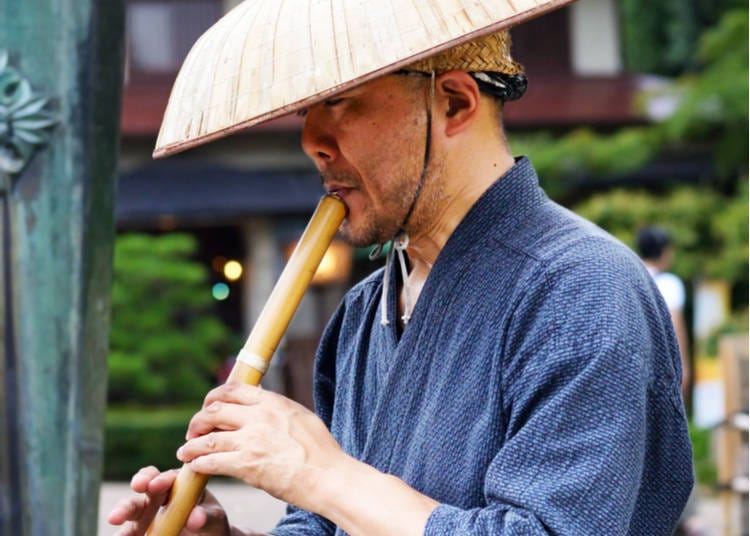
음악은 일본 문화의 큰 부분이다. 음악은 미디어, 경제, 심지어 패션 하위문화에도 영향을 미친다. 과거에는 전통 일본 악기가 왕실의 홀을 음악으로 장식하고 연극 공연을 반주했다.
오늘날에는 TV에서, 가부키 공연에서, 혹은 축제에서 들을 수 있다. 그래서 여기 오늘날에도 들을 수 있는 6가지 전통 일본 악기를 소개한다!
1. 샤쿠하치

가장 인기 있는 전통 일본 관악기 중 하나가 샤쿠하치다. 일본 피리로 더 잘 알려진 이 악기는 선불교도들이 '스이젠(吹禅)'이라고 알려진 명상 수행을 위한 영적 도구로 사용해왔다.
세로로 잡고 연주하는 샤쿠하치는 앞쪽에 4개, 뒤쪽에 1개의 구멍이 있으며 전통적으로 대나무로 만든다.
명상 목적으로 사용된 샤쿠하치 음악은 원래 공개 공연보다는 개인적인 영적 깨달음을 위해 사용되었다.
하지만 오늘날에는 승려들이 혼큐쿠, 즉 전통 샤쿠하치 레퍼토리를 연주하는 것을 콘서트에서 볼 수 있다.
2. 고토

일본의 국악기로 여겨지는 고토 공연은 반드시 봐야 할 목록에 있어야 한다. 고토는 바닥에 놓고 뜯어서 연주하는 일본 현악기로, 한국의 가야금과 중국의 정과 비슷하다.
전통적으로 고토는 13현과 17현 두 종류가 있다. 이제는 20현, 21현, 또는 25현까지 찾을 수 있다! 고토는 매우 큰데 보통 약 180cm 길이이며, 오동나무를 재료로 만든다.
고토로 만드는 음악은 낭만적이라고 한다. 주목할 만한 고토 연주자로는 야쓰하시 겐교, 사와이 다다오, 사와이 가즈에가 있다.
3. 산신

일본의 섬 음악은 카리브해 음악과는 꽤 다르다. 오키나와에서 온 뱀가죽으로 만든 일본 현악기인 산신은 보통 섬 생활과 연관 짓는 여유로운 비트보다는 더 독특한 울림을 가진다.
'산신'은 '세 개의 줄'이라는 뜻이고, 이 악기는 정확히 그렇다. 남성 줄, 중간 줄, 여성 줄이 있는데, 남성 줄은 가장 낮은 음을, 여성 줄은 가장 높은 음을 낸다.
산신은 종종 밴조와 비교되지만, 밴조와 달리 뜯어서 연주한다. 산신은 전통 류큐 민요나 오키나와의 졸업식 및 기타 특별한 의식에서 들을 수 있다. 흥미롭게도 산신 악보는 한자를 음표로 사용한다.
4. 샤미센

오늘날 가장 인기 있는 일본 악기 중 하나가 샤미센이다. 샤미센은 오키나와 산신의 변형으로 여겨지는 3현 류트다. 샤미센의 목 길이는 기타와 비슷하지만 프렛이 없다.
에도 시대에 샤미센은 분라쿠와 가부키 같은 전통 연극에서 인기리에 사용되었고, 고우타, 지우타, 나가우타 같은 스타일의 성악 공연을 반주했다.
오늘날 샤미센은 적응하고 발전했다. 요시다 브라더스 같은 현대 샤미센 연주자들은 그들의 음악에 더 많은 개성을 불어넣고 스타일을 더해 샤미센 음악을 현대로 가져왔다. 실제로 그들의 곡 "코도"는 2006년 북미에서 닌텐도 위 광고에 사용되기도 했다.
5. 비와

비와는 반드시 들어봐야 할 일본 악기다. 바치라고 불리는 큰 피크로 연주하는 짧은 목의 류트다.
여행하는 비와 연주자들인 비와호시는 한동안 꽤 인기가 있었다. 그들은 비와로 이야기를 반주했는데, 그 중 가장 유명한 것이 '헤이케 이야기'였다.
비와는 7세기부터 가가쿠(전통 일본 궁중 음악)에서 사용되어 왔지만, 메이지 시대에 현대 음악이 부상하면서 인기가 쇠퇴했다.
비와는 여러 변형이 있지만, 일반적으로 3-5개의 줄과 4-6개의 프렛을 가진다. 가장 유명한 유형은 사츠마 비와다.
최근에는 음악가들이 이 일본 현악기를 서양 음악에 접목시켜 되살리려고 노력하고 있다. 다케미쓰 도루 같은 작곡가는 "11월의 단계" 같은 작품으로 비와를 서양 관현악에 통합했다.
6. 다이코

국제적으로 가장 잘 알려진 일본 악기는 아마도 다이코 북일 것이다. 다이코 북은 일본의 많은 여름 축제와 전 세계 일본 문화 행사에서 볼 수 있는 북이다.
와다이코(和太鼓), 즉 일본 북은 다양한 크기와 모양으로 나온다. 한 예로는 모래시계 모양의 로프 텐션 북인 쓰즈미가 있다. 또 다른 것은 한 조각의 나무로 만든 북인 뵤우치다이코다. 가장 극적인 다이코는 오다이코다.
오다이코는 다이코 앙상블 뒤쪽에서 볼 수 있는 큰 북이다. 이 모든 북들이 쿠미다이코(組太皷)라고 불리는 다이코 북 앙상블에서 사용되는 것을 볼 수 있는데, 각 북은 특정한 역할을 가지고 있고 음성 호출이 연주자들의 조화를 돕는다. 또한 다이코를 직접 해볼 수도 있다. 도쿄의 많은 오락실을 방문해 '다이코 노 타츠진' 또는 '다이코 드럼 마스터'를 플레이해서 이 전통 일본 악기로 현대 J-팝 멜로디를 연주할 수 있다.
전통 일본 악기 공연
일본을 방문할 때 이런 전통 음악 행사나 콘서트 중 하나에 참석해보는 것은 어떨까?
전통 일본 악기를 듣는 것은 일본 문화에 대한 완전히 새로운 관점을 줄 수 있다. 이 악기들은 생존했을 뿐만 아니라, 전통 일본 음악은 현대 일본에서도 관련성을 유지하기 위해 적응했다. 다음에 도쿄를 방문할 때 이 6가지 전통 일본 악기를 주의 깊게 살펴보자!

Chief English Editor
LIVE JAPAN
2017년부터 라이브 재팬과 함께 일하고 있는 시니어 영어 에디터. 미국 뉴욕출신으로 일본에서 20년 이상, 디지털 미디어 분야에서 15년 이상 경력이 있다. 일본기업과 지역당국이 해외 시청자와 소통할 수 있도록 지원하는 데 중추적인 역할을 담당하고 있다. 여행을 하지 않을 때는 일본 최대 관광 플랫폼 중 하나인 LIVE JAPAN의 세련된 카피 제작을 한다. 뉴욕주립대학교 제네시오 캠퍼스에서 커뮤니케이션 학사 학위를 받았다.
※가격과 메뉴내용은 변경될 수 있습니다.
※특별히 기재된 것 이외에는 모두 세금이 포함된 가격입니다.
본 게시물을 읽으신 분들께 추천해 드리는 시설
-

Kambei Sannomiyahonten
불고기
고베/산노미야/기타노
-
어필

Rukku and Uohei
술집
삿포로/치토세
-

Jukuseiniku-to Namamottsuarera Nikubaru Italian Nikutaria Sannomiya
술집
고베/산노미야/기타노
-
상품

Yoshida Gennojo-Roho Kyoto Buddhist Altars
토산점/안테나샵
니조성/교토 고쇼
-

ISHIDAYA Hanare
불고기
고베/산노미야/기타노
-

Kanzenkoshitsuyakinikutabehodai Gyugyu Paradise Sannomiya
불고기
고베/산노미야/기타노
-

도쿄 관광의 새로운 코스! 히비야선 긴자역에서 세계 최고 수준의 일본 아트를 무료로 만나다.
by: Guest Contributor
-

【주술회전 팬 필독!】JR 동일본과 주술회전의 기적의 콜라보! 랩핑 신칸센으로 도호쿠를 순회하는 '동일본 회유'로 유동을 창조하라!
by: Guest Contributor
-

도쿄 관광의 새로운 보물! 도쿄 메트로 여객 안내소에 세계에서 단 하나뿐인 오리지널 기념 스탬프 등장
by: Guest Contributor
-

도쿄의 숨겨진 보석 ‘기치조지’에서 경험하는 겨울의 사치: 딸기 애프터눈 티 철저 가이드!
by: Guest Contributor
-
Ad

[2026년 1월 OPEN] THE SUMO LIVE RESTAURANT 히라쿠자 GINZA TOKYO 스모의 세계로 빠져들게 하는 5가지 감동 요소!
by: LIVE JAPAN 편집부
-

하네다 공항, 고질라에게 점령당하다! 세계 최대 고질라가 마중! 일본 방문객 필견의 HANEDA GODZILLA GLOBAL PROJECT
by: Guest Contributor













![[오사카] 템포 하버 시어터: 유테이지 라이브 쇼 입장권
상세 & 예약 ▶
(Photo: Klook)](https://rimage.gnst.jp/livejapan.com/public/article/detail/a/00/01/a0001807/img/ko/a0001807_parts_666a213f1a088.jpg?20250821142000&q=80&rw=280&rh=280)

![[동경아사쿠사] 첫 고토 체험 : 고토에서 애니메이션 노래, 히트곡 연주 (화과자 포함)
상세 & 예약 ▶
(Photo: Klook)](https://rimage.gnst.jp/livejapan.com/public/article/detail/a/00/01/a0001807/img/ko/a0001807_parts_68d390747756e.png?20250821142000&q=80&rw=280&rh=280)









